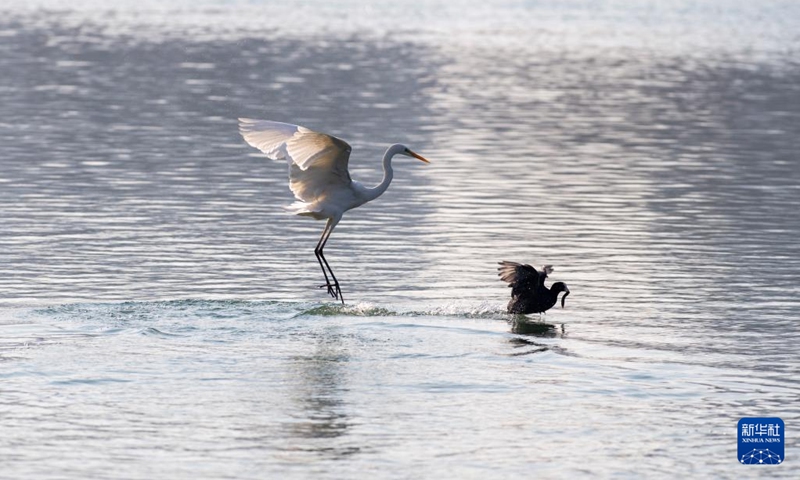China expands number of green public spaces with countrywide construction of pocket parks, wetland parks
In recent years, multiple cities across China have made full use of unused land, leftover land, and land around residents’ houses to establish pocket parks and green public spaces.
In March 2021, a sports cultural park was opened to the public in southwest China’s Chongqing Municipality after it was completed, with the park having been built by the city on the site of an unused sloping piece of land in the course of three months.
By making use of the land, the city was able to build recreational facilities for children, including a climbing facility and a sunken sand pool, while installing sport facilities in flatter areas.
“This place was filled with garbage and smelt bad in the past; but nowadays, it has turned into a backyard park for us,” said a local resident surnamed Yuan.
“As the geographical conditions of Chongqing are complicated, it is difficult to repurpose these small pieces of land found around residential communities. However, by building pocket parks like this one, we’ve turned land resources, which previously were considered difficult to make use of, into green public spaces for local citizens,” said Wang Haomin, director of the park management office under the Chongqing Urban Management Bureau. The city also planted flowers and plants inside the park in an attempt to turn it into a greener and more welcoming space.
“Pocket parks are an important and effective approach to improve the urban environment and boost urban greening, as well as an important carrier for improving residential community governance,” said Jia Jianzhong, general secretary of the Chinese Society of Landscape Architecture, who added that pocket parks are small, exquisite, beautiful, open to all, and are located near residential communities, making them easily accessible.
Chongqing has carried out more than 1,300 urban greening projects along slopes and cliffs, building public spaces with a total combined area of 30 million square meters, as statistics have revealed.
Nationwide, the country has built more than 20,000 pocket parks and paved more than 80,000 kilometers of green lanes, with the area of parks and green spaces being about 15 square meters per capita for urban residents.
An official from the urban construction department under the Ministry of Housing and Urban-Rural Development explained that the country will continue to construct a park system underpinned by a fair distribution of parks so that local citizens can find parks and green spaces within a radius of several hundred meters in their cities. In addition, the functions of these urban parks, including providing a space for citizens to enjoy leisure activities and perform physical exercise, as well as preventing fires and other disasters, will be constantly improved.

An egret is seen at Fenhe river wetland park in Taiyuan, north China's Shanxi Province, Dec. 28, 2021. (Photo/Xinhua)
The Fenhe River Wetland Park located in Taiyuan city, north China’s Shanxi Province has effectively improved its urban ecosystem after the water quality of the local river was treated and improved. In the springtime, willow trees have started sprouting up around the area, with grass growing all over inside the park and rare birds spotted fluttering about here and there.
However, just 10 years ago, the overall water quality of Fenhe River was comparatively low. In the summer, the river would always produce an unpleasant smell and was filled with garbage. According to a local citizen, due to sand mining operations along one section of the river, the river would also often dry out in the winter.
In recent years, Taiyuan has adopted various measures to treat water pollution in the Fenhe River and its nine tributaries. Hence, the Fenhe River Wetland Park was eventually established for this purpose. “The wetland park is like a huge sponge. Yet, if polluted water continues flowing into it, the park will not be able to play its role properly no matter how helpful it is in storing and purifying water,” introduced Shao Shejiao, deputy director of the Department of National Resources of Shanxi Province.
Xu Demao, deputy director of the Ecology and Environment Bureau of Taiyuan, said they had investigated about 1,000 sewage outlets along the Fenhe River and its tributaries in an effort to combat water pollution, having effectively prevented the rivers from being further polluted.
After the Fenhe River Wetland Park was completed, the level of water storage in the Taiyuan section of the Fenhe River increased by 20 percent. Currently, about 165 species of birds can be seen in the wetland park all year round, including purple herons and spot-billed ducks, among other species.
In recent years, an increasing number of cities in China have built their own wetland parks. Statistics have indicated that through their campaigns fighting against water pollution, 295 cities at or above the prefecture level have been successful in basically eliminated “black and odorous” water bodies, with the number of wetland parks of various types having now exceeded 1,600 in all across the country.
Photos
Related Stories
- Beijing parks see rise in visitors during holiday
- Chinese mythology-themed park kicks off construction in Wuhan
- Sanjiangyuan National Park carries out patrol in 2022
- People enjoy themselves at winter recreation park in Harbin
- Hula Nature Reserve, Hula Lake park closed to prevent spread of H5N1 avian influenza
- View of Baixi Park in Putuo District of Shanghai
- China unveils route map for building national cultural parks
- Yuanmingyuan Ruins Park opens for free on its 161st anniversary of destruction
- Beijing parks welcome over 2 mln visitors during holiday
- China's Zhejiang to build sea island parks
Copyright © 2022 People's Daily Online. All Rights Reserved.










